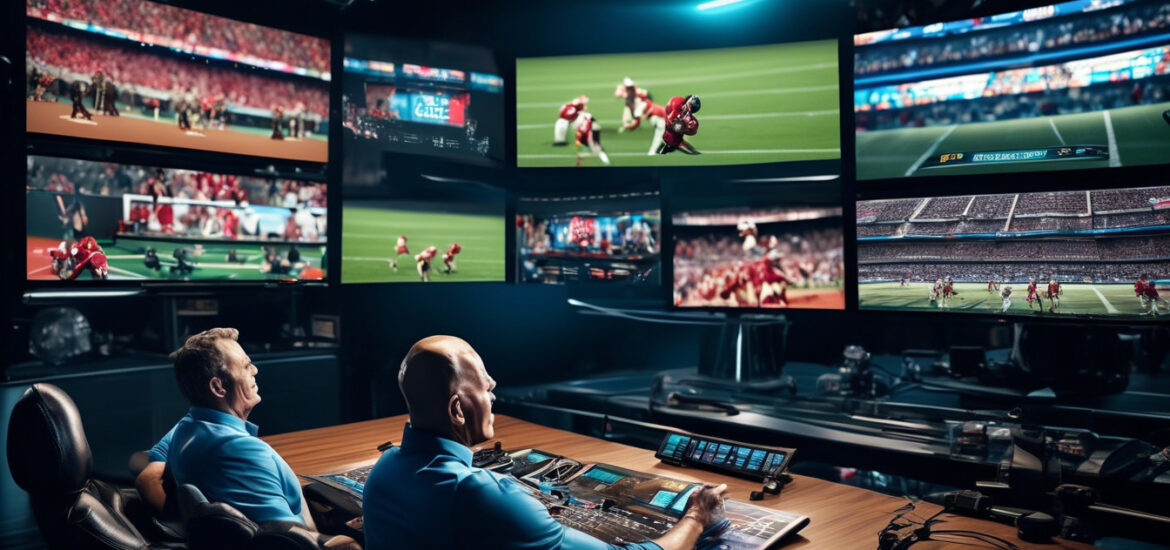As we gather around our screens to enjoy the thrill of live sports broadcasts, we’ve noticed a growing phenomenon that seems to be competing for our attention: sports betting advertisements. This surge in advertising is not just a fleeting observation but a significant part of the broadcast experience.
Together, we find ourselves wondering just how much of our viewing time is actually spent watching these advertisements. In this article, we aim to explore:
- The percentage of a typical sports broadcast that is devoted to sports betting ads
- How this aspect has quietly woven itself into the fabric of our sports-watching rituals
By examining the data and trends, we hope to shed light on the extent of this integration and its implications for both the sports industry and us, the viewers.
Join us as we delve into the numbers and uncover the impact of sports betting advertisements on our beloved broadcasts.
The Growing Presence of Betting Ads
In recent years, there has been a significant increase in the number of betting ads during sports broadcasts. These advertisements have almost become a staple of our shared viewing experience. As we gather with friends and family to enjoy our favorite games, these betting ads are appearing more frequently, blending seamlessly into the fabric of our sports culture.
While we can’t deny the excitement they bring, there’s also a growing conversation about their impact on our viewer experience.
As we navigate this changing landscape, we must also consider the regulatory considerations that come into play. With the surge in betting ads, there’s a pressing need to ensure that they adhere to guidelines designed to protect viewers, especially the younger audience.
We find ourselves in a unique position to shape how these advertisements are integrated into our sports broadcasts. The goal is to enhance, not detract from, our experience. It’s about finding that balance where everyone feels included and respected in the world of sports entertainment.
Impact on Viewer Experience
As we dive into the impact of these ads, it’s crucial to acknowledge how they can both enhance and disrupt our enjoyment of the game.
Betting advertisements have become a staple in sports broadcasts, offering us exciting opportunities to engage more deeply with the action. They can make us feel more connected to the event, giving an extra layer of thrill. However, they can also shift our focus from the game itself, sometimes overwhelming us with constant prompts and odds updates.
The viewer experience can become fragmented, as the ever-present betting ads might divert our attention and alter how we perceive the sport. While we appreciate the sense of community these ads can foster among fans, there are regulatory considerations to ponder.
Ensuring a balanced presence of advertisements is vital to maintain the integrity of our sports experience. We need regulations that:
- Protect our enjoyment.
- Keep the game itself at the heart of our viewing experience.
- Prevent drowning us in commercialism.
By addressing these aspects, we can enjoy a more cohesive and immersive sports experience.
Proportion of Ad Time
We must carefully consider how much airtime is allocated to sports betting ads during broadcasts. As a community of sports enthusiasts, it’s essential to understand the balance between engaging content and the influx of betting advertisements.
Current Observations:
- These ads are a growing presence, sometimes taking up a significant portion of the broadcast.
- They can affect our viewer experience, shifting focus from the game itself to the allure of betting opportunities.
Viewer Perspectives:
- Some viewers appreciate the convenience of betting information.
- Others find the frequency overwhelming.
It’s crucial for us to discuss the impact this has on our enjoyment of sports.
Regulatory Considerations:
- Regulations play a key role in determining how much advertising is appropriate.
- We need to ensure these regulations align with our community’s values to keep broadcasts enjoyable and not overly commercialized.
By staying informed and voicing our opinions, we can help shape a viewing experience that feels inclusive and balanced.
Comparison Across Sports
Football:
Football broadcasts are characterized by a strong presence of sports betting advertisements. These ads are often:
- Integrated seamlessly into the viewer experience.
- Displayed during pre-game, halftime, and post-game analyses.
This ensures that fans remain engaged throughout the entire broadcast.
Basketball:
Basketball takes a slightly more subtle approach to betting advertisements. Here, ads typically appear:
- During timeouts.
- In brief intermissions.
This strategy helps maintain the game’s flow, keeping it largely uninterrupted by advertisements.
Baseball:
Baseball’s slower pace provides:
- More natural breaks within the game.
- Opportunities for frequent betting ads.
While this can enhance the viewer experience for some, it may feel intrusive to others.
Regulatory Considerations:
- Different sports have varying regulatory guidelines.
- Some leagues enforce stricter rules to balance advertising with maintaining the integrity of the game.
Conclusion:
By understanding these differences, fans can better appreciate how each sport navigates the complex landscape of sports betting advertisements.
Influence on Broadcasting Strategies
Broadcasting strategies are significantly shaped by the integration of sports betting, as networks aim to enhance engagement and viewer retention. We’re witnessing an era where betting advertisements aren’t just add-ons but central to the viewing experience.
By weaving these ads into broadcasts, networks create a dynamic atmosphere that keeps us hooked, eager for every moment. It’s not just about the game anymore; it’s about the thrill of potential outcomes and shared excitement.
Regulatory considerations must be navigated carefully. Various jurisdictions impose limitations on how and when these advertisements can appear, pushing networks to be more creative in their approach. We strive for a balance that respects these rules while still engaging our audience.
Our viewer experience is at the forefront of these strategies. We aim to ensure that the ads enhance rather than disrupt the broadcast. By skillfully integrating betting content, we foster a sense of community and belonging among those who tune in, making every game feel like a shared journey.
Viewer Perceptions and Reactions
Many viewers express mixed feelings about sports betting ads in broadcasts, as they can both enhance excitement and cause distractions. We often find ourselves caught between the thrill of placing a bet and the annoyance of frequent interruptions.
Betting advertisements can add a layer of engagement, making us feel more involved in the game. However, too many ads can disrupt our viewer experience, pulling us away from the camaraderie we seek in watching sports together.
- Some of us appreciate the adrenaline rush these ads bring, especially when we gather with friends, sharing the highs and lows of our bets.
- Others might feel overwhelmed by the sheer volume of these promotions, longing for a more straightforward game-watching experience.
As we navigate this landscape, we must consider how these ads affect our enjoyment. Although regulatory considerations are crucial, our shared experiences and reactions shape the ongoing conversation about the role of betting advertisements in sports broadcasts.
Regulatory Considerations
The Balance Between Sports Betting Ads and Viewer Experience
We need to examine how regulations can balance the excitement of sports betting ads with the need to protect viewers from excessive exposure. As a community, we thrive on the thrill of sports and the shared excitement of a big game. However, the rise of betting advertisements during broadcasts can heavily impact our viewer experience. It’s essential that we consider regulatory considerations to ensure these ads don’t overwhelm the primary purpose of enjoying sports.
Implementing Thoughtful Regulations
By implementing thoughtful regulations, we can maintain a sense of community while acknowledging the reality of sports betting. We must advocate for guidelines that limit the frequency and duration of these ads, ensuring they enhance rather than detract from our experience.
Key Regulatory Considerations:
-
Frequency Limits:
- Regulate how often betting ads appear during a broadcast.
-
Duration Caps:
- Set maximum time limits for each betting advertisement.
-
Content Guidelines:
- Ensure ads convey responsible betting messages.
Protecting Vulnerable Audiences
Such regulations should aim to protect vulnerable audiences, like young viewers, from being overly influenced.
Creating a Balanced Environment
Together, we can create a balanced environment where we enjoy sports, engage with betting responsibly, and feel part of a community that looks out for each other.
Future Trends and Predictions
As we look ahead, we anticipate that technological advancements and evolving viewer preferences will shape the future of sports betting advertising.
We foresee betting advertisements becoming more integrated into the viewer experience, offering personalized content that resonates with each of us. Imagine a seamless blend of live sports action and tailored betting insights, creating a cohesive viewing environment that feels like a community we’re part of.
In this future landscape, advertisers will harness:
- Data analytics
- AI
These tools will ensure that ads are relevant and engaging, enhancing our connection to the game.
However, we must also consider regulatory considerations that will inevitably arise. Balancing innovation with responsible advertising will be crucial, ensuring that our shared spaces remain enjoyable and safe.
As members of the sports community, we’ll likely see a shift towards more immersive and interactive advertisements that respect our preferences while adhering to guidelines.
Together, we’ll navigate these changes, ensuring a viewer experience that feels inclusive and engaging.
Conclusion
The Pervasive World of Sports Betting Advertising
You’ve delved into the pervasive world of sports betting advertising during broadcasts. The significant and increasing presence of these ads impacts viewers’ experiences and raises concerns about the proportion of time dedicated to them.
Key Concerns:
- The balance of content versus advertising during broadcasts
- The potential influence on viewer behavior and attitudes
- Ethical considerations regarding the promotion of gambling
Evolving Regulations and Viewer Reactions:
As regulations evolve and viewers react, broadcasters must carefully navigate this landscape.
- Stay informed about changes in advertising regulations.
- Monitor viewer feedback and adjust strategies accordingly.
- Balance advertising revenue with viewer satisfaction.
The Future of Sports Betting Advertising:
The future holds uncertainties, but understanding current trends is crucial for all stakeholders involved in sports broadcasting.
- Broadcasters need to be proactive in addressing both regulatory changes and viewer expectations.
- Stakeholders must collaborate to ensure responsible advertising practices.
By focusing on these areas, broadcasters can better manage the impact of sports betting advertising on their audiences and maintain a positive viewer experience.

